A framework for systematic conservation planning.
In this section we summarise the framework presented in Pressey and Bottrill (2009). They suggest that the systematic conservation planning process occurs in eleven stages. The process is not unidirectional — there are many feedbacks and reasons for revised decisions about priority areas.
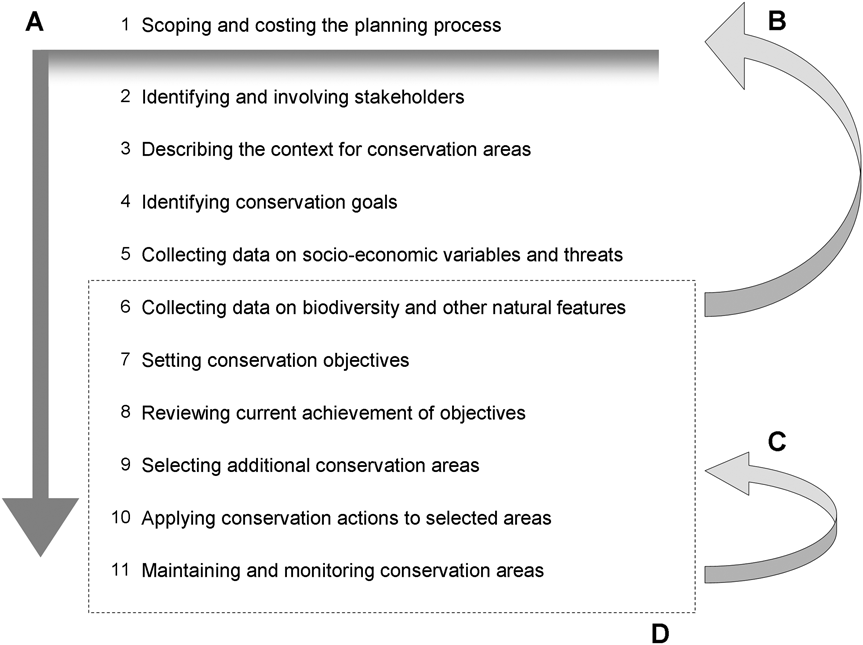
Above we show a diagrammatic representation of the process of conservation planning as 11 main stages. Pressey & Bottrill 2009 have depicted the planning process as a linear sequence but, in practice, some stages will be undertaken simultaneously and there will be many feedbacks from later to earlier stages. From the time that stakeholders are first involved, for example, they will contribute in different ways throughout the process (A). Among the reasons for feedbacks are possible revisions of the boundaries of the planning region when biodiversity data are collected (B). Another involves lessons for planning decisions (Stage 9) from maintenance (Stage 11) that indicate ways of locating and configuring conservation areas to minimize subsequent liabilities for management (C). Below, we develop these 11 stages a bit further.
At the inception of the planning process the initial boundaries of the planning domain are identified, although later work, for example on identifying stakeholders and collecting data on biodiversity and threats, may lead to boundaries being revised. Decisions are also necessary about the size and composition of the planning team and the funds that are available or have to be raised to address subsequent stages adequately.


The early involvement of stakeholders, including governments, affected communities, and experts, has important benefits for the effectiveness of conservation planning. These include: eliciting information on biodiversity and planning opportunities that is not held in databases and would otherwise be unavailable; understanding the concerns and requirements of people likely to be affected and benefited by conservation actions; engendering trust and credibility among key players; engaging with people who may facilitate conservation actions financially and politically; and gaining the support of organizations and local communities responsible for implementing conservation actions and maintaining conservation areas into the future.
This stage sets the scene for all the tasks that follow. Its importance lies mainly in understanding the social, economic and cultural conditions in the planning region and how these shape constraints or opportunities for conservation. Part of this context is an understanding of which threats can be addressed spatially, through conservation actions in particular areas, and which require complementary non-spatial actions such as, for example, new local policies and regulations to facilitate environmental protection.
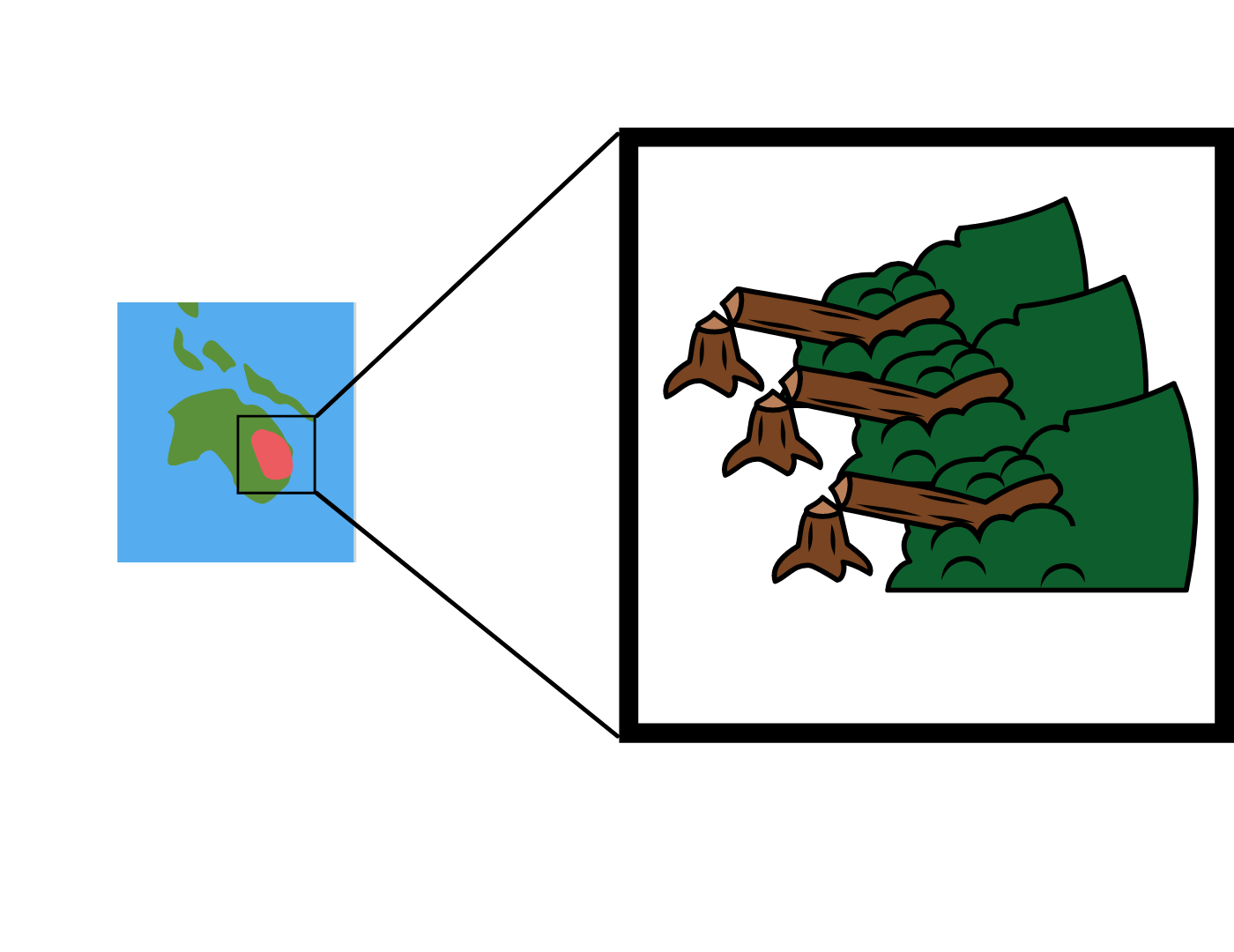

Goals are broad qualitative statements that provide a bridge between the values and beliefs upon which conservation efforts are based and the more specific, often quantitative, objectives used in systematic conservation planning. The very generality of goals can help to promote agreement among stakeholders, perhaps beginning with a vision statement for the planning region. An important purpose of goals is also to focus planning teams on the kinds of spatially explicit data that will be required (Stages 5 and 6).
By this stage, context, and goals will have clarified the need for spatially explicit data on socio-economic variables that will influence decisions about specific actions and areas and potentially make conservation decisions more effective. These variables include previous and existing conservation efforts, the costs of conservation (e.g., acquisition and management costs, opportunity costs to users of natural resources; Naidoo et al., 2006), threats to biodiversity and other natural values, and constraints on, and opportunities for, conservation action.


Spatially explicit data on biodiversity have been fundamental to systematic conservation planning since its earliest application (Kirkpatrick, 1983), playing a vital, often dominant, role in shaping recommendations for investments. A characteristic of systematic conservation planning is its applicability to different kinds and amounts of data, making it relevant to virtually any terrestrial region and many marine regions. Recently, data on ecosystem services and other contributions of nature to people have become increasingly important in spatial planning.
A hallmark of systematic conservation planning is its use of explicit conservation objectives or targets, representing the interpretation of goals through the filter of available data. Objectives, especially quantitative ones (e.g., the extent of each representation unit or the number of occurrences of each special element), necessitate discussion about outcomes for biodiversity, limit the potential for expedient, residual conservation decisions, and encourage accountability (Margules & Pressey, 2000). Quantitative objectives allow the full potential of decision-support software to be realized (Sarkar et al., 2006). Qualitative objectives are, however, almost always needed because of our inability to assign numerical parameters to all aspects of biodiversity pattern and process (e.g., shape, connectivity, and species composition related to past extractive uses). Qualitative objectives are typically expressed as characteristics to be maximized, minimized or preferred. One of their disadvantages is that their achievement is, by definition, open to personal judgement, limiting repeatability and accountability.

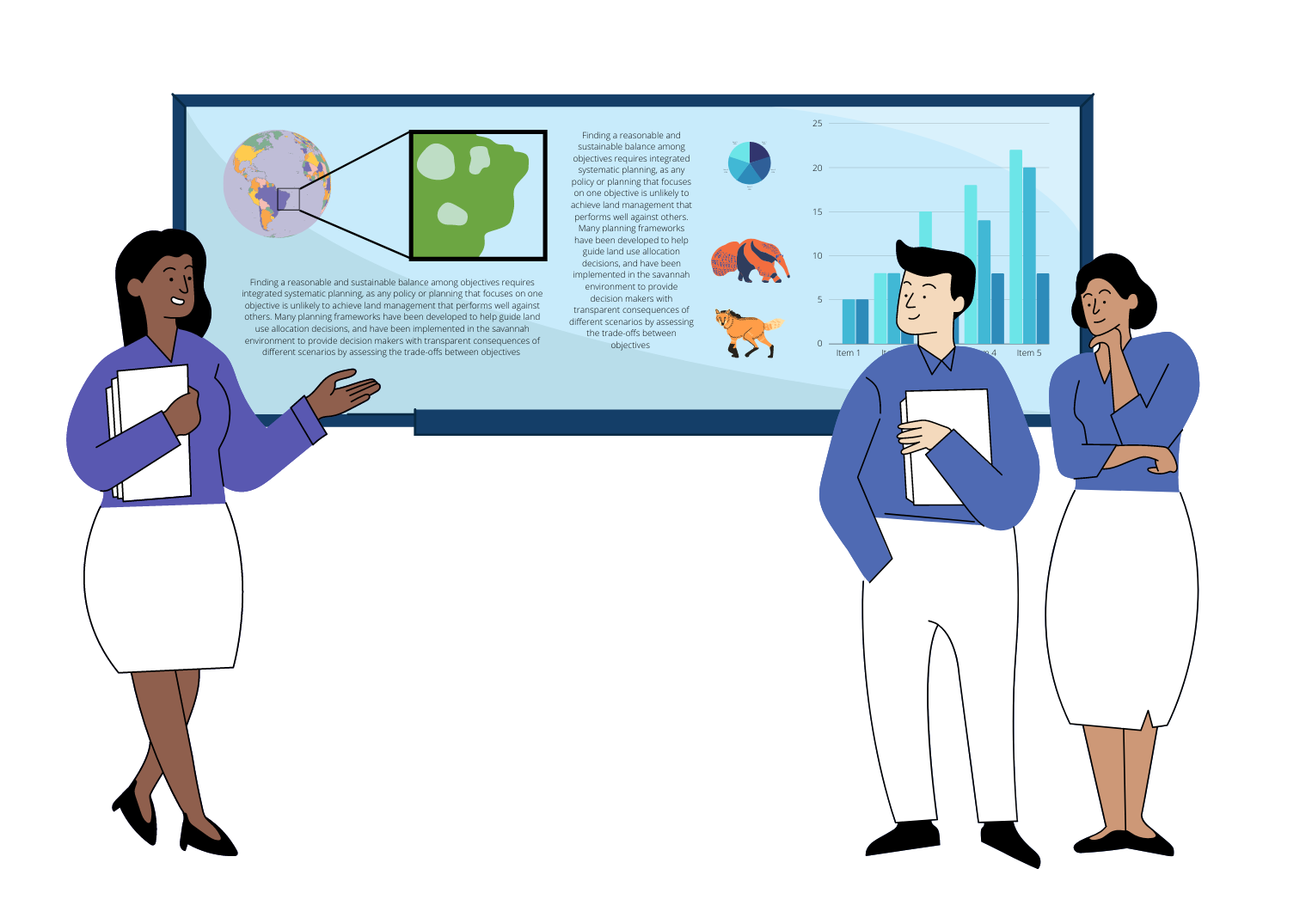
In few landscapes or seascapes, planners will work with a blank slate, devoid of conservation actions or previous attempts to identify priorities. In most cases there will be sufficient cultural or legal backing for existing conservation areas to lock them into the architecture of the new plan (Margules & Pressey 2000). In other cases, some established conservation areas may be regarded as preferences, not commitments (e.g., non-statutory reserves; Cowling et al., 2003). Existing conservation areas will often contribute to the achievement of objectives. A major purpose of this stage is to review this achievement of goal considering existing conservation areas, also known as Gap Analyses, before selecting new, complementary areas.
Selecting additional conservation areas is what many people would associate with the term conservation planning. Three points are most relevant in this context.
Firstly, no matter how carefully and inclusively new conservation areas are identified, changes to these areas will usually be necessary before conservation actions are applied (in Stage 10). Some areas, for example, will be unexpectedly lost and some data on vegetation types and species localities will inevitably prove to be wrong.
Secondly, because many factors that determine which conservation actions are eventually applied to specific areas cannot often be predicted accurately across whole landscapes or seascapes, this stage typically identifies generic conservation areas, not spatially explicit combinations of particular actions.
Thirdly, selection often has two aspects: analysis with decision-support systems to map the options for achieving objectives, and judgement by experts and other stakeholders to resolve these options drawing on knowledge not captured in data sets. Ideally, both aspects together will help planners balance objectives for biodiversity with the aspirations of people.
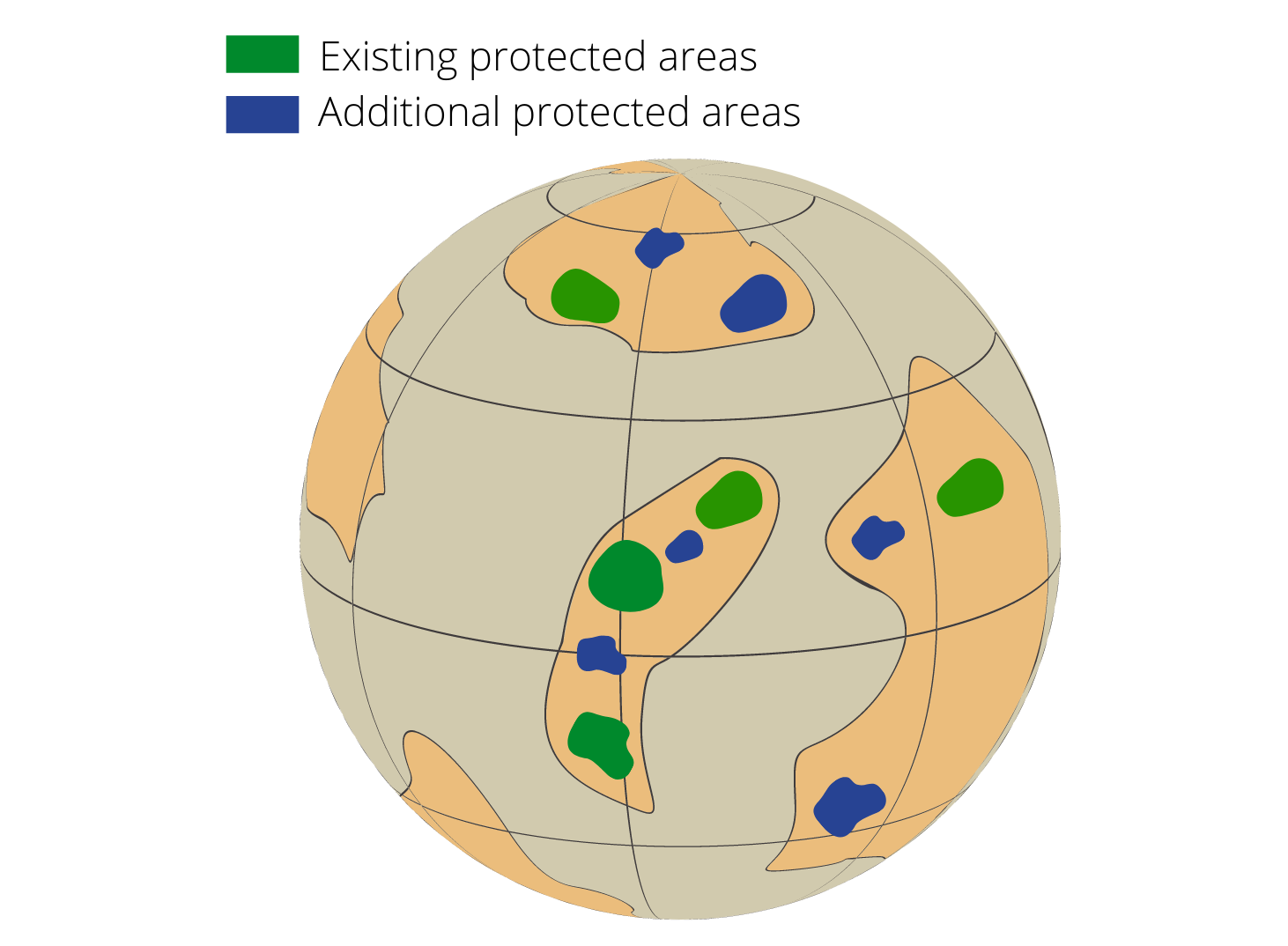

Notwithstanding the increasing effectiveness of systematic conservation planning in shaping real decisions (Pressey et al., 2009, Sinclair et al. 2018), the process has often lacked continuity of information and personnel between Stage 9 and this stage (Pierce et al., 2005). There are two important consequences.
Firstly, some aspects of applying conservation actions have not had the attention they deserve. These include: managing changes to selected areas and preferred actions imposed by unexpected constraints on conservation actions, scheduling incremental conservation actions within the limits of annual budgets, and mainstreaming plans into the activities of organizations responsible for planning and development. The second consequence is that much careful and expensive planning has failed to achieve its potential outcomes.
Stage 11 concerns ongoing management of conservation areas. Its main purpose is to ensure that the values for which conservation areas have been established are maintained. This requires each area to be placed in its landscape or seascape context so that its particular contributions to objectives can be identified.
Management then proceeds with a similar set of stages to the whole planning process but focused on individual areas (Margules & Pressey, 2000), with objectives identified, zoning and management activities allocated, and their effectiveness monitored, with adjustment as required.
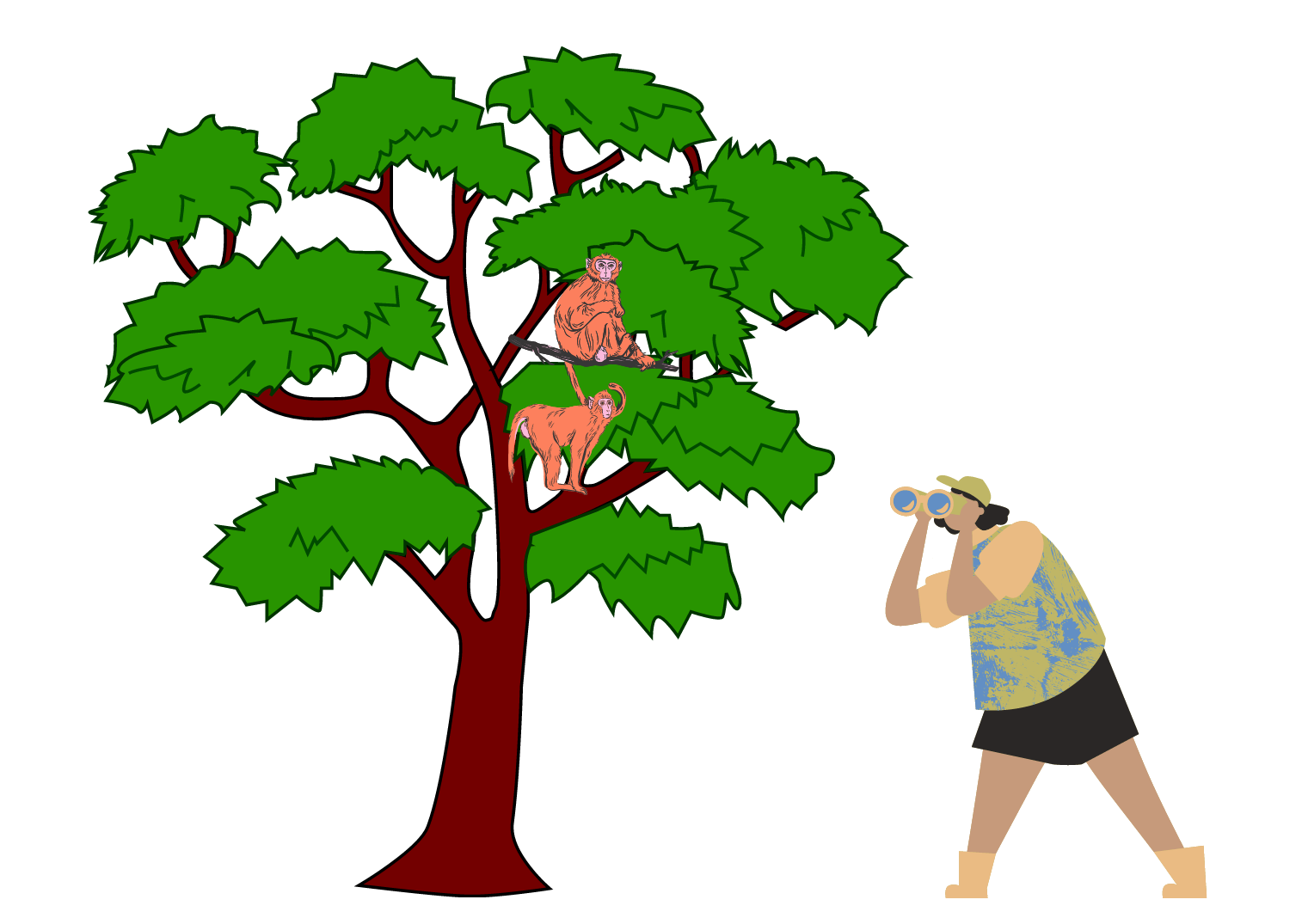
OTHER FRAMEWORKS AND FURTHER READING.
Margules, C. R., & Pressey, R. L. (2000). Systematic conservation planning. Nature, 405(6783), 243-253.
Knight, A.T., Cowling, R.M. & Campbell, B.M. (2006) An operational model for implementing conservation action. Conservation Biology, 20, 408–419.
Conservation measures partnership (2007) Open Standards for the Practice of Conservation, v.2.0. http://conservationmeasures.org/CMP/Site_Docs/CMP_Open_Standards_Version_2.0.pdf
REFERENCES.
Cowling, R.M., Pressey, R.L., Rouget, M. & Lombard, A.T. (2003) A conservation plan for a global biodiversity hotspot—the Cape Floristic Region, South Africa. Biological Conservation, 112, 191–216.
Kirkpatrick, J.B. (1983) An iterative method for establishing priorities for the selection of nature reserves: an example from Tasmania. Biological Conservation, 25, 127–134.
Margules, C. R., & Pressey, R. L. (2000). Systematic conservation planning. Nature, 405(6783), 243-253.
Naidoo, R., Balmford, A., Ferraro, P. J., Polasky, S., Ricketts, T. H., & Rouget, M. (2006). Integrating economic costs into conservation planning. Trends in ecology & evolution, 21(12), 681-687.
Pressey, R. L., & Bottrill, M. C. (2009). Approaches to landscape-and seascape-scale conservation planning: convergence, contrasts and challenges. Oryx, 43(4), 464-475.
Pressey, R.L., Watts, M.E., Barrett, T.W. & Ridges, M.J. (2009) The C-Plan conservation planning system: origins, applications, and possible futures. In Spatial Models for Conservation (eds Moilanen, A., Possingham, H.P. & Wilson, K.A.), pp. 211–234. Oxford University Press, Oxford, UK.
Sarkar, S., Pressey, R.L., Faith, D.P., Margules, C.R., Fuller, T., Stoms, D.M., Moffett, A., Wilson, K.A., Williams, K.J., Williams, P.H. and Andelman, S. (2006) Biodiversity conservation planning tools: present status and challenges for the future. Annual Review of Environment and Resources, 31, 123–159.
